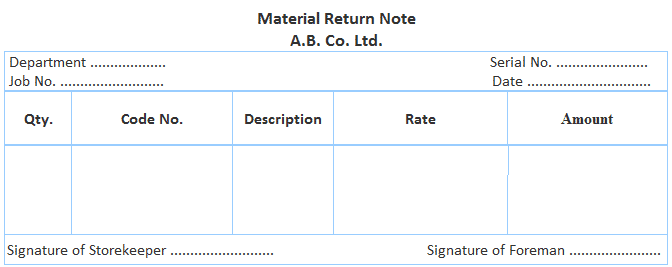Usually, the materials that are obtained for a specific job are not fully consumed or they are drawn in excess of requirements. The excess quantity is returned to the stores, together with a material return note. The storekeeper should place the returned materials in the appropriate bin. In turn, a record of the materials should also be entered into the "In" or "Received" column of the bin card. Two copies of the material return note are prepared. One copy is retained by the department that returned the materials and the other is kept by the storekeeper, who receives the note along with the materials returned. Notably, a material return note is similar to material requisition. To avoid confusion, material return notes may be issued in red ink or printed on different-colored paper. The material return note is forwarded to the costing office, where the rate and amount are entered. Additionally, the necessary credit for the value of the materials returned is allocated to the particular job.Format of Material Return Note

Material Return Note: Explanation
Material Return Note FAQs
A material return note is prepared to determine the value of materials that have been returned. Therefore, it is necessary to prepare a separate note in addition to the one that was originally issued when the materials were received from stores.
One copy is retained by the department that returned the materials and the other is kept by the storekeeper, who receives the note along with the materials returned.
The material return note is forwarded to the costing office, where the rate and amount are entered. Additionally, the necessary credit for the value of the materials returned is allocated to the particular job.
Materials are only allowed to be returned when it is reasonable to do so and does not involve any waste or spoilage, or create a likelihood that wasteful practices will recur.
No, a separate note is not required to be completed at the time of receiving returned materials because one was already prepared earlier.
True Tamplin is a published author, public speaker, CEO of UpDigital, and founder of Finance Strategists.
True is a Certified Educator in Personal Finance (CEPF®), author of The Handy Financial Ratios Guide, a member of the Society for Advancing Business Editing and Writing, contributes to his financial education site, Finance Strategists, and has spoken to various financial communities such as the CFA Institute, as well as university students like his Alma mater, Biola University, where he received a bachelor of science in business and data analytics.
To learn more about True, visit his personal website or view his author profiles on Amazon, Nasdaq and Forbes.











